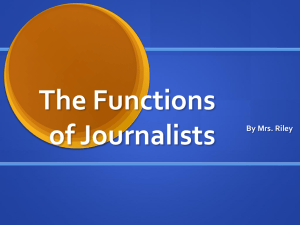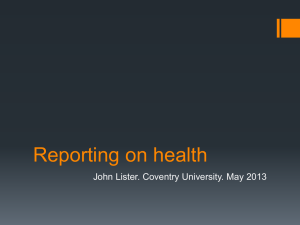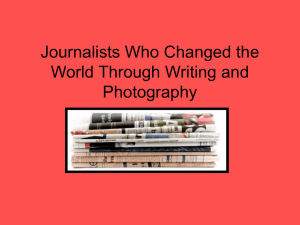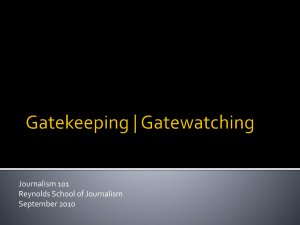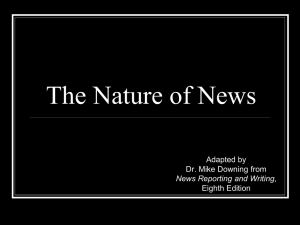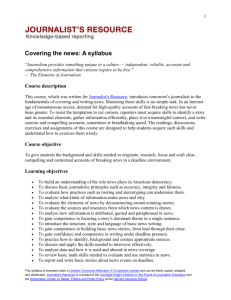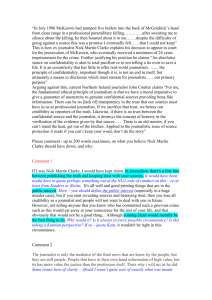JOURNALISM_112_NOTES
advertisement
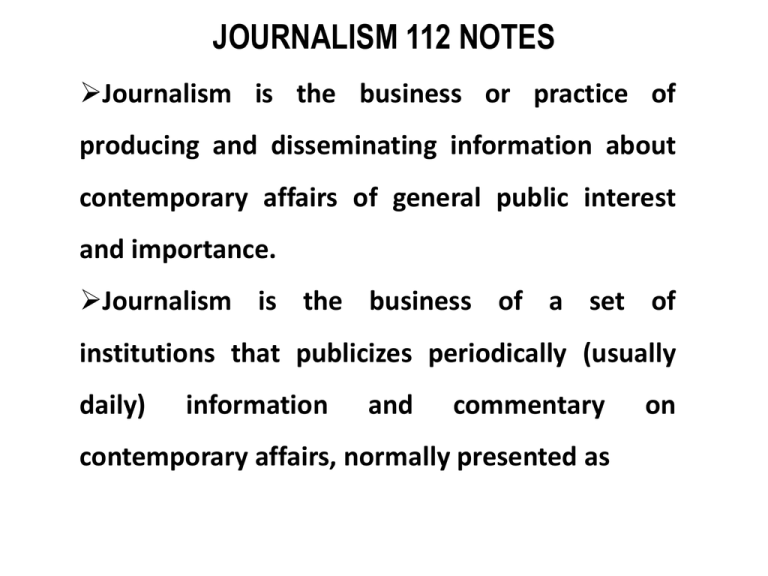
JOURNALISM 112 NOTES Journalism is the business or practice of producing and disseminating information about contemporary affairs of general public interest and importance. Journalism is the business of a set of institutions that publicizes periodically (usually daily) information and commentary contemporary affairs, normally presented as on true and sincere, publicly include the audience in a discourse taken to be publicly important. The core purpose of journalism is and should be about producing and distributing serious information and debate on central social, political, and cultural matters. Journalists regulate much of what the public gets to know about the world the inhabit, and this activity is vital to a functioning democracy. DEMOCRATIC EXPECTATIONS OF JOURNALISM Journalism is presumably animated by certain democratic expectations. Some of these concern the relationship of journalism to government- e.g. the proposition that, acting on behalf of the citizenry, the press should guard against abuses of power by office holders. Others concern the relationship of journalism to diverse opinion sources-e.g. the proposition that the press should provide a robust, uninhibited, and wide-open marketplace of ideas, in which opposing views may meet, contend, and take each other’s measure. Others concern the relationship of journalism to the public at large-e.g. the propositions that the press should serve the public’s right to know and offer options for meaningful political choices and nourishment for effective participation in civic affairs. WHAT IS NEWS? Many attempts have been made to define news. Here are some of them News is the unusual: “When a dog bites a man, that is not news; but when a man bites a dog, that is news”. News is anything that interest us: “News is something you didn’t know before, had forgotten or didn’t understand”. News is the latest information: “News is the earliest intelligence of events with a bearing upon the lives of the mortals”. News is a valuable record of events: “News is the first draft of history”. News is a form of creative writing: “Journalism is literature under pressure”. News is about people, especially famous people: “Names make news” News is an objective picture of the world: “Facts are sacred; comment is free” News is what people try to keep hidden: “News hurts. The rest is advertising” NEWS VALUES AND NEWS PRODUCTION News values, sometimes called “news criteria,” are commonly held to be active at several stages in the gate-keeping process. News values are used in two ways: (1) They are criteria of selection from material available to the newsroom of those items worthy of inclusion in the final product. (2) They are guideline for the presentation of items, suggesting what to emphasize, what to omit, and where to give priority in the preparation of the items for presentation to the audience. NEWS VALUES 1. Guideline for presentation of news 2. Criteria for news selection WHAT MAKES NEWS? 1. FREQUENCY—Events that unfold conveniently within the production cycle of a news outlet are more likely to be reported. 2. THRESHOLD—The larger the event, the more people it affects, the more likely it is to been reported. Events can meet the threshold criterion either by being large in absolute terms, or by marking an increase in the intensity of an ongoing issue. 3. UNAMBIGUITY—The fewer ways there are of interpreting an event, the more likely it is to be reported. 4.MEANINGFULNESS—The more culturally proximate and/or relevant an event is, the more likely it is to be reported. 5. CONSONANCE—If a journalist has a mental pre-image of an event, if it’s expected to happen, then it is more likely to be reported. This is even more true if the event is something the journalist desires to happen. 6. UNEXPECTEDNESS—If an event is unexpected, it is more likely to be considered newsworthy and to be reported. 7. CONTINUITY—Once an issue has made the news once, future events related to it are more likely to be reported. 8. COMPOSITIONAL BALANCE—News editors will attempt to present their audience with a “balanced diet” of news. An event that contributes to the diversity of topics reported is more likely to be covered than one that adds to a pile of similar news items. 9. ELITE NATIONS—Events that involve elite nations are more likely to be reported than those that do not. 10. ELITE PEOPLE—Events that involve elite people are more likely to be reported than those that do not. 11. PERSONIFICATION—Events that can be discussed in terms of the actions of individual actors are more likely to be reported than those that are the outcome of abstract social forces. By the same token, social forces are more likely to be discussed in the news if they can be illustrated by way of reference to individuals. 12. NEGATIVITY—An event with a negative outcome is more likely to be reported than one with a positive outcome. TYPES OF NEWS: HARD NEWS AND SOFT NEWS. News stories are basically divided into two types: Hard news generally refers to up-to-the-minute news and events that are reported immediately, e.g. Politics, war, economics and crime Soft news is background information or humaninterest stories e.g. arts, entertainment and lifestyles. News Features- this is a term for news that is not necessarily time-sensitive. • A good feature might be about the people in your community and their struggles, victories and defeats, • A feature usually focuses on a certain angle, explores it through background research and interviews with the people involved, and then draws conclusions from that information. WHERE THE NEWS COMES FROM Journalists find news in all sorts of places, but most stories originate in one of three basic ways: NATURALLY OCCURRING EVENTS, like disasters and accidents; PLANNED ACTIVITIES, like meetings and news conferences; REPORTERS’ ENTERPRISE UNPLANNED EVENTS frequently become major news stories e.g ship sinking, plane crash, tsunami, or mudslide. THE JOURNALIST’S ROLE Journalism is more than just the distribution of fact-based information. Unlike a propagandist, the journalist sorts through the information available and determines how much of it is valuable and reliable before passing it on to the public. Propaganda may be based on facts, but those facts are presented in such a way as to influence people’s opinions. Public Relations Professionals use facts, but may tell only one side of a story. Journalists, on the other hand, strive to be fair and complete. PR professionals writing about their organizations are unlikely to include information that might make the organization look bad. On the other hand, a journalist will attempt to provide a complete picture, even if it is not entirely positive. Another distinction between journalism and other forms of information is that journalists strive for independence from the people they cover. THE CONCEPTS OF OBJECTIVITY AND FAIRNESS 1. The ideal of objectivity holds that facts can be separated from values or opinions and that journalists act as neutral transmitters who pass along events to an audience. 2. Journalistic ideal of objectivity stresses factual (especially investigative) reporting over commentary, the balancing of opposing viewpoints, and maintaining a neutral observer role for the journalist. 3. The journalistic ideal of objectivity prescribe that reporters should stand above the political battle, serve the public rather than politicians with partisan axes to grind, and do so with due regard for all the interest at stake in the issue. The journalist has an obligation to meet high professional standards of informativeness, accuracy, objectivity and balance in news reporting. truth, THE ELEMENTS OF JOURNALISM Journalism’s first obligation is to the truth. Its first loyalty is to citizens. Its essence is a discipline of verification. Its practitioners must maintain an independence from those they cover. Journalism must serve as an independent monitor of power It must provide a forum for public criticism and compromise. It must strive to make the significant interesting and relevant. It must keep the news comprehensive and proportional. Its practitioners must be allowed to exercise their personal conscience METHODS OF NEWS GATHERING The four most commonly used met hods in news gathering used by journalists are: Observation Telephone conversations Research and Interviews. 1. OBSERVATION Observation consists of your actually seeing of an event taking place and then reporting what you have seen in the form of a news story. The difference between a good story and a poor one is often in the skill of the observer. Skilled observers use their eyes, ears, mind, notebooks and tape recorders. They make sure they get the concrete facts, specific figures and accurate information. They look for the colorful, the dramatic or the unusual in any situation. 2. TELEPHONE CONVERSATIONS The telephone plays an important role in your daily work as a journalist. It saves time, legwork and it enables you to reach people who are ordinarily too busy to see you in person. Telephone conversations may range from full -scale interview to brief queries to verify or amplify information. But regardless of how often you use this method of news gathering, you should keep the following points in mind: Know what information you want keep your pencil and paper handy. Speak politely indistinct, well-modulated tones. Be cheerful and businesslike. Make sure you get your facts straight. Ask the other person to repeat figures or spell out names. Avoid three-way conversations among yourself, the person on the telephone and somebody else in your office. Recheck your information by reading it back to the person who has given it to you. Record the conversation using a “tele phone pick-up” Be sure to inform the person on the other end that you are recording the conversation for note-taking purposes only. Do not discuss classified information. 3. RESEARCH Research is nothing more than digging out information from files and reference works. Research is used to verify or amplify facts in news stories and to give depth to features stories and magazines articles. 4. INTERVIEWS About 90 percent of everything in a news story is based on some form of interviewing. Journalist in search of information must learn how to get along with people and How to treat people with tact and understanding while still accomplishing his/her purpose. TYPES OF INTERVIEWS NEWS INTERVIEW The news interview is based on “hard news,” some event or development of current and immediate interest. TELEPHONE INTERVIEW The power of persuasion is often necessary to elicit information from a reluctant person CASUAL INTERVIEW An accidental encounter between a journalist and a news source on the street or at a social gathering can often result in a tip that arouses the curiosity of a writer. PERSONALITY INTERVIEW In the personality interview an effort is made to let the reader see the appearance, mannerisms, background and even the character of the subject. SYMPOSIUM INTERVIEW News developments of current interest require a journalist or a team of journalists to seek information not from one or two sources but from a dozen. NEWS CONFERENCE: The person interviewed at a news conference may be: President, Managers, Movie Star or Any other person promoting what is believed to be a news story of interest to the public. PREPARED QUESTION INTERVIEW When direct person-to-person questioning cannot be arranged with an important source, journalists occasionally resort to giving that source a set of prepared questions to which a reply is requested. GROUND RULES 1. ON THE RECORD Journalists are free to use all material from the interview, including information and quotations, and to identify the source. 2. NOT FOR ATTRIBUTION Journalists are free to use information and quotations, but they agree not to identify the source. "Not for attribution" is an acceptable method of gathering information. 3. OFF THE RECORD Journalist agrees not to use information from the source or journalist may agree not to use the information unless he/she checks with the source before publication. 4. DEEP BACKGROUND The information can be used in or to inform a story and it can lead a journalist to other sources for confirmation. Nonetheless, the source providing information on Deep Background may not be identified in any way, nor can the reporter say how the information was obtained. BASIC NEWS WRITING Journalists don’t want their stories told from the beginning of a news event. – They focus on the end result, and then may go back to the beginning. – They like giving away the ending. – They are more interested in the outcome. News writing is about the only form of writing in which you start with the climax. This story form is widely known as the inverted pyramid. The inverted pyramid has a “news summary lead” that is followed by series of paragraphs arranged in descending order of importance. This movement from greater to lesser information can be demonstrated in a geometric shape – the pyramid. After the information news and summary quotes lead, provide the subsequent background and explanation, present facts and color, explore other issues, clarify conflict, speculate on cause and effect. STORY ORGANIZATION 1. The lead. 2. Material that explains and amplifies the lead. 3. Necessary background material 4. Secondary or less important material. 5. Descending pyramids. Narrative. 6. Transitions 7. Quotes 8. Ending. HOW TO WRITE A NEWS LEAD 1. Condense story into one or two words. Put those words as close to the beginning of the first sentence as possible without destroying the flow of the lead sentence. 2. Keep leads short — 20 to 30 words for the first sentence or fewer. 3. The news lead should tell the reader what the story is about and be interesting enough to draw the reader into the rest of the story. 4. Find the action in the story. Put the action in the lead. 5. Always double-check names and numbers. Check spelling, style and grammar. Put everything in order. 6. Attribute opinions. Stick with the facts. 7. Details, description. Report first, then write. Learn all, tell 10 percent. 8. Decide which of the news values best applies to the lead of the story. Write a lead that emphasizes that news value. 9. Write in the active voice. 10. Don’t lead with a name, time or place unless that is the most interesting/important thing in the story. THE LEAD The lead is the first word, sentence or paragraph of the story. Sometimes it can be two or three paragraphs. The Leads answer the 5 Ws and the H (who-what-whenwhere –why and how) elements of the story. The rest of the story should support and elaborate on the lead and also provide the information that didn’t make the cut up top. THE RULES FOR A GOOD LEAD KEEP IT SHORT. News writing is always tight, but the lead calls for special care. GET TO THE POINT. What is the story about? FOCUS ON THE ACTION. Use the "active voice.“ HOOK THE READER. Put the most important, the most interesting, the most exciting thing in the lead. ELEMENTS OF GOOD WRITING 1. PRECISION. Use the right word. Say exactly what you mean. Be specific. Avoid sexism in your writing. Use generic terms: firefighters 2. CLARITY. Use simple sentences. Noun, verb. 3. PACING. Movement of sentences create a tone, mood for the story. 4. TRANSITIONS. Progress logically from point to point. Put everything in order. 5. SENSORY APPEAL. Appeal to one or more of our five senses: sight, hearing, smell, taste and touch. 6. USING ANALOGIES. Describe it as being “like” or “as” something that is familiar to readers. Attribution • The practice of identifying all sources in a story • A phrase that tells readers the source of the a quote or information used in the story • It identifies the source of the information reported, particularly in any controversial statements or questionable information. Attribution can be explicit or implied. Example of explicit or direct attribution: “The man was arrested and charged with murder, police sergeant Antonio Costa said.” Example of implied or indirect “Police arrested the man and charged him with murder.” Police Sergeant Antonio Costa said Quotes and Sound Bites Quotes provide a personal connection to the story. Quotation must be attributed so the audience knows who said it. Direct quotes are at least one sentence long and are in the exact words of the speaker. E.g. "We will build nothing lasting without fighting discrimination, which is a poison for society.” Zuma said Partial quotes, primarily used in print, can be just a word or a phrase the speaker said. E.g “Jacob Zuma… launched an appeal to combat the ‘poison’ of racial discrimination.” Endings Endings often echo beginnings, in that they return to an important place or a person. In a chronological narrative, the ending is what happens last. Endings frequently look toward the future. Occasionally a story may end with a strong quote or a sound bite. WRITING AND EDITING News Managers, the Editors, and Producers decide what to run, what to drop, and what to hold They choose and change the stories of the day based on importance, interest, new developments, and the time or space available. The editor’s job is to ensure that the stories presented to the public are well written and presented, as well as accurate, complete, and fair. NEWSPAPER JOBS Newspaper editors assign the stories, they edit the written text or “copy,” and they supervise the design and layout of pages. In addition, newspapers may have a photo editor who oversees a staff of photographers, as well as a graphics editor who supervises the work of artists creating maps, charts, and other informational graphics. BROADCAST JOBS • Broadcast newsrooms are not organized like newspapers. • Most broadcast reporters do not specialize in covering a particular type of story, but may instead be assigned to specific news broadcasts like the early morning news or the late night news. Each of these broadcasts is put together by a producer, who decides what stories will air, at what length, and in what order. Broadcast newsrooms have presenters or “anchors” who appear on the air and introduce the stories the reporters have covered that day. Radio and television anchors usually appear on more than one newscast per day. THE EDITOR’S ROLE Editors need good news judgment because; they serve as assignment managers, responsible for deciding what stories will be covered and by whom They must be good writers in order to help to shape the story as it is developing, discussing it with reporters in the field and deciding where to deploy more people to cover additional angles. Editors are directly involved in decisions about story presentation, writing or choosing headlines, captions, photos, and illustrations. Newspaper editors check copy, choose illustrations — either graphics or photos — and decide how the story will be laid out on the page as well as the headline. In most broadcast newsrooms, reporters do not record their scripts or assemble their stories until a producer has approved the content. Producers also decide the order of stories in the newscast and the amount of time to be allocated to each story. COPY EDITING Good writing, by definition, requires rewriting. An accuracy check is the first level of copy-editing. Editors look for grammatical and usage errors, as well as for spelling mistakes. Editors make sure that all numbers in a story are correct: addresses, telephone numbers, ages, date, and time references. They confirm that the reporter has used proper titles for everyone who is quoted, and they review the use of attribution throughout the story. HEADLINES, CAPTIONS, AND TEASES In newspapers and online newsrooms, editors write headlines for stories and captions for photos. A headline is both a summary and an advertisement. A caption is more of a label, telling readers what the photograph or graphic shows. In broadcast newsrooms, producers may write headlines and also what are called teases. Teases, are short descriptions of stories designed to make listeners or viewers want to stay tuned to get the full report. LEAD WRITING EXERCISES At least 15 dead, 175 injured in worst accident following in Amtrak’s three 132-year Conrail history locomotives’ collision in Baltimore, Maryland yesterday. Or At least 15 dead in worst accident in Amtrak’s 132-year history following three Conrail locomotives’ collision, leaving 175 injured in Baltimore, Maryland yesterday. A nuclear weapon with a yield equivalent to 150,000 tons of TNT detonated 40 miles from a meeting of pacifists and 2,000 feet beneath the surface of Pahute Mesa in the Nevada desert on Tuesday. A 27-year old, Ellen Lynn Conner, was arrested and charged with Oregon charges of kidnapping and interference with a custody warrant following the three years missing of the 7-years old boy in Brick Township, NJ The arrest followed the neighbor’s recognition of the child’s picture when it was shown after the movie Adam on Monday. Fourty passengers were evacuated from a Northwest Airlines jet, Flight 428 at the LaCrosse, Wis. Municipal Airport after a landing tower employee spotted smoke near the wheels following a flight from Minneapolis to LaCrosse on Monday. The smoke was due to the hydraulic fluids leaking onto hot landing brakes and injuries were reported no fire or HEADLINES Three Conrail locomotives collision claimed 15 lives Nuclear testing weapon detonated in Nevada desert Mother faces Oregon charges Fourty passengers evacuated from Northwest Airlines jet HARD AND SOFT LEAD Former rebel leader Joshua Smith was elected prime minister tonight/yesterday, winning more than 80 percent of the vote in the country’s first democratic election since 1993. SOFT LEAD Growing up in Youngtown, Joshua Smith was a little boy with big dreams. Always small for his age, he says the bigger boys at school bullied him. When he told his grammar school teacher he’d be prime minister some day, she laughed. • No one is laughing now. Smith won yesterday’s election with more than 80 becoming percent the of the vote, country’s first democratically elected leader since 1993.

